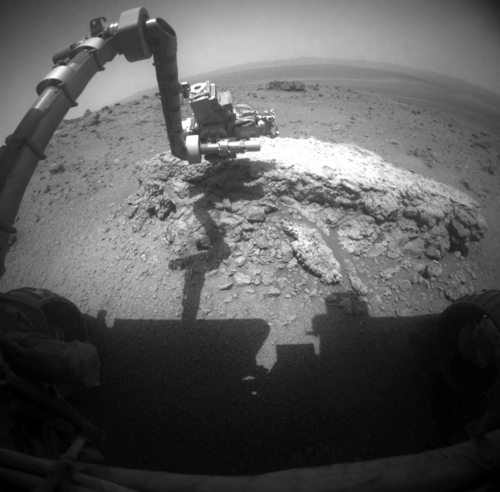WASHINGTON - A new site being explored by the Mars rover Opportunity has yielded soil samples unlike any examined before on the red planet and that appear more favorable for life, scientists said Tuesday. Opportunity, the indefatigable robot that has been exploring Mars for seven and a half years, arrived three weeks ago at the edge of a 22 kilometer (13.6 mile) wide crater named Endeavour and has been sending back images of the surrounding environment.

<관련기사>
화성 로봇, 더운 물 흔적 또 발견
예정 수명을 훨씬 넘긴 미항공우주국(NASA)의 화성 표면 탐사로봇 오퍼튜니티가 새로운 장소에서 먼 옛날에 흘렀거나 스며나온 따뜻한 물의 증거를 발견했다고 스페이스 닷컴이 2일 보도했다.
NASA 과학자들은 오퍼튜니티호가 지름 22㎞의 거대한 엔데버 크레이터 가장자리의 암석 틴스데일 2에서 아연과 브롬의 농도가 특이하게 높은 것을 발견했다고 발표했다. 이들 원소는 물, 그 중에서도 특히 더운 물에 의해 퇴적되는 원소이다.
지구상에서 생명체가 탄생하려면 물과 에너지만 있으면 되며 열수계에는 미생물이 우글거린다. 따라서 화성에서 고대 생명체의 증거를 찾으려면 지금은 비록 건조하고 차갑지만 이런 장소가 최적지이다.
오퍼튜니티의 쌍둥이 로봇인 스피리트는 지난 2007년 착륙지 부근에서 고대 열수계의 증거를 발견했다. 과학자들은 오퍼튜니티의 자료를 해석중이지만 엔데버 크레이터의 가장자리에도 이런 열수계가 있을 것으로 생각하고 있다.
이들은 아연 성분이 많은 암석은 통상적으로 열수활동이 진행되는 곳에서 형성된다면서 오퍼튜니티가 발견한 암석이 바로 이런 열수계의 단서로 보인다고 말했다.
연구진은 더 나아가 이 열수계가 앞서 스피리트가 발견한 것보다 더 흥미진진할 가능성이 있다고 보고 있다. 스피리트가 발견한 열수계의 물은 산성이 매우 높았지만 궤도탐사선 자료에 따르면 엔데버 크레이터 주변에는 산성 환경에서는 형성되지 않는 진흙 광물이 많은 것으로 나타나 이 곳의 암석과 토양이 보다 중성일 가능성이 높다는 것이다.
NASA 과학자들은 "놀랍게도 3개월간 활동할 예정이었던 오퍼튜니티가 7년8개월이 지난 지금 새로운 임무에 착수하고 있다"고 말했다.
오퍼튜니티와 스피리트는 지난 2004년 1월 화성에 착륙해 물의 증거를 찾는 작업을 해 왔으며 그 결과 고대 화성은 생각보다 훨씬 따뜻하고 물이 많은 곳이었다는 많은 증거를 찾아냈다.
이후 스피리트는 지난 해 3월 통신을 중단했고 NASA는 지난 5월 스피리트의 사망을 선언했다.
그러나 오퍼튜니티는 기어의 마모도를 편중시키지 않기 위해 몇년 전부터 내려진 후진 지시에 따르지 않는 등 노후 증상을 보이고 있긴 하지만 지금까지 목표치의 30배가 넘는 33.5㎞를 탐사하는 놀라운 능력을 보였다.
NASA 과학자들은 오퍼튜니티가 2008년 8월부터 설정했던 목적지인 엔데버 크레이터에 마침내 도착한데 경탄하면서 "이 곳은 지금까지 탐사했던 어느 곳과도 다르며 가장 많은 것을 보여줄 수 있는 장소"라고 기대감을 표시했다. (연합뉴스)

![[Herald Interview] 'Amid aging population, Korea to invite more young professionals from overseas'](http://res.heraldm.com/phpwas/restmb_idxmake.php?idx=645&simg=/content/image/2024/04/24/20240424050844_0.jpg&u=20240424200058)



